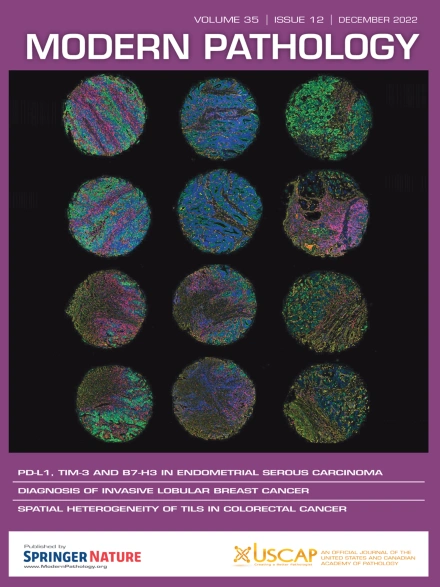并非所有HER2阳性乳腺癌都是相同的:肿瘤内异质性、低水平HER2扩增及其对新辅助治疗反应的影响。
IF 5.5
1区 医学
Q1 PATHOLOGY
引用次数: 0
摘要
HER2阳性乳腺癌通常采用新辅助抗HER2和化疗(NACT)治疗。然而,治疗反应各不相同,有一部分肿瘤显示出高残留癌症负担(RCB)。本研究探讨了HER2免疫组织化学(IHC)肿瘤内异质性(ITH)、低水平HER2扩增与肿瘤对NACT的反应之间的关系。有可用RCB结果的205例nact后HER2阳性乳腺癌分为5个HER2组:IHC 3+ (HER2 IHC阳性,未行FISH), 1-高组(FISH HER2拷贝bbb8或HER2/CEP17比值bbb4), 1-中间组(HER2拷贝bbb6至8或比值>至4),1-低组(HER2拷贝4至6,比值2至3)和3组(HER2拷贝≥6,比值< 2)。低水平HER2扩增,统称为HER2拷贝数4-8或HER2/CEP17比率本文章由计算机程序翻译,如有差异,请以英文原文为准。
Not All HER2-Positive Breast Cancers Are the Same: Intratumoral Heterogeneity, Low-Level HER2 Amplification, and Their Impact on Neoadjuvant Therapy Response
Human epidermal growth factor receptor 2 (HER2)-positive breast cancers are frequently treated with neoadjuvant anti-HER2 and chemotherapy (NACT). However, treatment response varies, with a subset of tumors showing high residual cancer burden (RCB). This study investigates the relationship between HER2 immunohistochemical (IHC) intratumoral heterogeneity (ITH), low-level HER2 amplification, and tumor response to NACT. A total of 205 post-NACT HER2-positive breast carcinomas with available RCB results were classified into the following 5 HER2 groups: (1) IHC 3+ (HER2 IHC positive, no fluorescence in situ hybridization performed), (2) Group 1-High (fluorescence in situ hybridization HER2 copies > 8 or HER2/CEP17 ratio > 4), (3) Group 1-Intermediate (HER2 copies > 6-8 or HER2/CEP17 ratio > 3-4), (4) Group 1-Low (HER2 copies 4-6 and HER2/CEP17 ratio 2-3), and (5) Group 3 (HER2 copies ≥ 6 and HER2/CEP17 ratio < 2). Low-level HER2 amplification, collectively designated as HER2 copies 4 to 8 or HER2/CEP17 ratio < 4, was associated with reduced response to HER2-targeted therapy and higher RCB post-NACT. HER2 IHC ITH, defined as the presence of at least 3 distinct staining intensities, with at least 10% of tumor cells exhibiting weak or no staining, was significantly more prevalent in low-level HER2 amplification groups (Group 1-Intermediate: 93.3%, Group 1-Low: 87.5%, and Group 3: 80.0%) compared with high-level amplification groups (IHC 3+: 24.7% and Group 1-High: 28.6%) (P < .001). Both low-level HER2 amplification and HER2 IHC ITH, regardless of hormone receptor status, were independently associated with poor treatment response, and tumors demonstrating both features had the highest likelihood of low therapeutic efficiency. These findings suggest that both low-level HER2 amplification and HER2 IHC ITH contribute to poor NACT response and may warrant alternative therapeutic strategies. Further prospective studies are needed to refine the clinical significance of low-level HER2 amplification and IHC ITH, particularly in the context of novel HER2-targeted therapies such as antibody-drug conjugates.
求助全文
通过发布文献求助,成功后即可免费获取论文全文。
去求助
来源期刊

Modern Pathology
医学-病理学
CiteScore
14.30
自引率
2.70%
发文量
174
审稿时长
18 days
期刊介绍:
Modern Pathology, an international journal under the ownership of The United States & Canadian Academy of Pathology (USCAP), serves as an authoritative platform for publishing top-tier clinical and translational research studies in pathology.
Original manuscripts are the primary focus of Modern Pathology, complemented by impactful editorials, reviews, and practice guidelines covering all facets of precision diagnostics in human pathology. The journal's scope includes advancements in molecular diagnostics and genomic classifications of diseases, breakthroughs in immune-oncology, computational science, applied bioinformatics, and digital pathology.
 求助内容:
求助内容: 应助结果提醒方式:
应助结果提醒方式:


